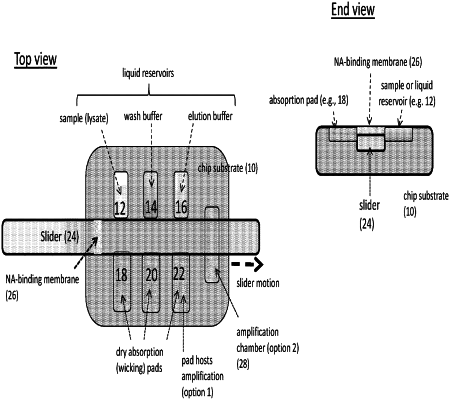| CPC B01L 3/502715 (2013.01) [B01L 3/5023 (2013.01); B01L 3/50273 (2013.01); B01L 7/52 (2013.01); B01L 7/525 (2013.01); B01L 2200/0621 (2013.01); B01L 2200/10 (2013.01); B01L 2300/0654 (2013.01); B01L 2300/0825 (2013.01); B01L 2300/126 (2013.01); B01L 2400/0406 (2013.01); B01L 2400/0457 (2013.01); C12Q 1/6844 (2013.01)] | 18 Claims |

|
1. A testing method that integrates a processing and an analysis of a sample containing an analyte, comprising:
(a) loading the analyte onto a binding membrane of a testing device comprising:
a substrate having an upper area surface that defines at least three laterally aligned reagent reservoirs and a lower area surface upon which are disposed at least three sections of adsorbing material, wherein each of the sections is aligned with at least one of the at least three reservoirs; and
a slidebar upon which is mounted the binding membrane and which slidebar is slidably attached to the substrate so that the sidebar can be slidably moved along a hypothetical horizontal plane that bisects the substrate upon application of a horizontal-directed force;
wherein the slidebar may be slid in the horizontal plane to bridge, in series, one of the at least three reservoirs and one of the at least three sections of absorbing material to place the reservoir and the section of adsorbing material bridged in fluidic communication with one another,
(b) placing a reagent to isolate, purify or concentrate the analyte into each of the at least three laterally aligned reagent reservoirs independently;
(c) processing the sample to derive the analyte by sliding the slidebar in the hypothetical horizontal plane to bridge in series each of the at least three laterally aligned reagent reservoirs wherein the movement of the slidebar causes the sample or reagent liquids to be wicked via capillary force through the membrane so that the analyte is isolated, purified and/or concentrated to a captured analyte; and
(d) eluting the captured analyte from the membrane.
|